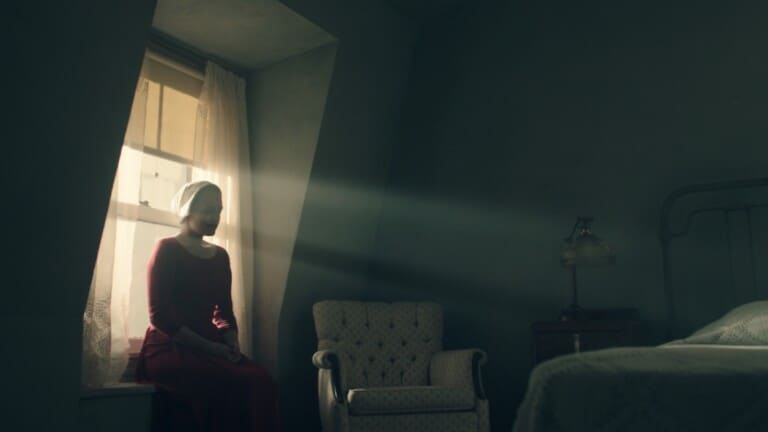A chair, a table, a lamp. Above, on the white ceiling, a relief ornament in the shape of a wreath, and in the centre of it a blank space, plastered over, like the place in a face where the eye has been taken out. There must have been a chandelier, once. They’ve removed anything you could tie a rope to.
A window, two white curtains. Under the window, a window seat with a little cushion. When the window is partly open – it only opens partly – the air can come in and make the curtains move. I can sit in the chair, or on the window seat, hands folded, and watch this. Sunlight comes in through the window too, and falls on the floor, which is made of wood, in narrow strips, highly polished. I can smell the polish. There’s a rug on the floor, oval, of braided rags. This is the kind of touch they like: folk art, archaic, made by women, in their spare time, from things that have no further use. A return to traditional values. Waste not want not. I am not being wasted. Why do I want?
On the wall above the chair, a picture, framed but with no glass: a print of flowers, blue irises, watercolour. Flowers are still allowed. Does each of us have the same print, the same chair, the same white curtains, I wonder? Government issue?
Think of it as being in the army, said Aunt Lydia.
A bed. Single, mattress medium-hard, covered with a flocked white spread. Nothing takes place in the bed but sleep; or no sleep. I try not to think too much. Like other things now, thought must be rationed. There’s a lot that doesn’t bear thinking about. Thinking can hurt your chances, and I intend to last. I know why there is no glass, in front of the watercolour picture of blue irises, and why the window only opens partly and why the glass in it is shatterproof. It isn’t running away they’re afraid of. We wouldn’t get far. It’s those other escapes, the ones you can open in yourself, given a cutting edge.
So. Apart from these details, this could be a college guest room, for the less distinguished visitors; or a room in a rooming house, of former times, for ladies in reduced circumstances. This is what we are now. The circumstances have been reduced; for those of us who still have circumstances.
But a chair, sunlight, flowers: these are not to be dismissed. I am alive, I live, I breathe, I put my hand out, unfolded, into the sunlight. Where I am is not a prison but a privilege, as Aunt Lydia said, who was in love with either/or.
The bell that measures time is ringing. Time here is measured by bells, as once in nunneries. As in a nunnery too, there are few mirrors.
I get up out of the chair, advance my feet into the sunlight, in their red shoes, flat-heeled to save the spine and not for dancing. The red gloves are lying on the bed. I pick them up, pull them onto my hands, finger by finger. Everything except the wings around my face is red: the colour of blood, which defines us. The skirt is ankle-length, full, gathered to a flat yoke that extends over the breasts, the sleeves are full. The whitewings too are prescribed issue; they are to keep us from seeing, but also from being seen. I never looked good in red, it’s not my colour. I pick up the shopping basket, put it over my arm.
The door of the room – not my room, I refuse to say my – is not locked. In fact it doesn’t shut properly. I go out into the polished hallway, which has a runner down the centre, dusty pink. Like a path through the forest, like a carpet for royalty, it shows me the way.
The carpet bends and goes down the front staircase and I go with it, one hand on the banister, once a tree, turned in another century, rubbed to a warm gloss. Late Victorian, the house is, a family house, built for a large rich family. There’s a grandfather clock in the hallway, which doles out time, and then the door to the motherly front sitting room, with its flesh tones and hints. A sitting room in which I never sit, but stand or kneel only. At the end of the hallway, above the front door, is a fanlight of coloured glass: flowers, red and blue.
There remains a mirror, on the hall wall. If I turn my head so that the white wings framing my face direct my vision towards it, I can see it as I go down the stairs, round, convex, a pier-glass, like the eye of a fish, and myself in it like a distorted shadow, a parody of something, some fairy-tale figure in a red cloak, descending towards a moment of carelessness that is the same as danger. A Sister, dipped in blood.
At the bottom of the stairs there’s a hat-and-umbrella stand, the bentwood kind, long rounded rungs of wood curving gently up into hooks shaped like the opening fronds of a fern. There are several umbrellas in it: black, for the Commander, blue, for the Commander’s Wife, and the one assigned to me, which is red. I leave the red umbrella where it is, because I know from the window that the day is sunny. I wonder whether or not the Commander’s wife is in the sitting room. She doesn’t always sit. Sometimes I can hear her pacing back and forth, a heavy step and then a light one, and the soft tap of her cane on the dusty-rose carpet.
The Handmaid’s Tale, chapter 2.
Chapter 2 of The Handmaid’s Tale shows a fragmented vision of the room and details the layout of the house. Offred seems to have a very clear awareness although nothing is explicit. However fragmented she is, she is clearsighted about Gilead in very strategic places in the text, in a very subtle way so she would not be accused if she ever happened to be discovered.
This passage is the beginning of the second chapter of The Handmaid’s Tale by Margaret Atwood. Offred, the main character, is alone in a bedroom. First, we will see how she describes her environment. Then, we will focus on how Offred reflects on Gilead and the Handmaids’ behaviour. Finally, we will analyze Offred’s coping with the system.
Strategic story-telling: a narrator that knows but who “intends to last”
The room
Impression of nudity due to the use of noun phrases at the beginning of:
- paragraph 1: “a chair, a table, a lamp”
- paragraph 2: “a window, two white curtains”
- paragraph 3: “a print of flowers, blue irises, watercolour”
- paragraph 5: “a bed”
- paragraph 6: “so”.
Paragraphs 1 and 2 could be seen in black and white. Colour only appears in paragraph 3 with “blue irises”.
This scene can be imagined filmed. The camera would follow the different elements of the description that tend to transform the room into a prison cell.
The house (inside)
Description of the way she takes to go from her room to the hallway: “hallway” (upstairs) and “pink carpet”, “staircase”, “the clock”, “the mirror”, “hat-and-umbrella stand”. All of these elements show she lives in a wealthy house.
As Offred describes her environment, she makes some reflections on Gilead. There is a shift from perception to thought.
Reflections on Gilead: the narrator begins to piece together her present situation
Reflections on Gilead
Paragraph 1, line 5: “they’ve removed anything you could tie a rope to.”
Paragraph 2, line 4: “there’s a lot that doesn’t bear thinking about”. They removed everything so that girls cannot commit suicide. No chance for those who refuse the system: thinking and committing suicide is prohibited.
“Return to traditional values”: in Gilead, women must stay at home to do the housework.
“Flowers are still allowed”: shows how Gilead’s system puts the pressure on individuals. There is no more liberty, everything is decided for the people, it’s censorship and dictatorship.
“Thinking can hurt your chances” is another example of Gilead’s censorship. There are no more differences between people and no more individuality, the people are only a pawn in the game of Gilead.
Reflections on the Handmaids’ behaviour
“bell”, “ritual”: are reminiscent of a prisoner in a cell.
“their red shoes”: Offred is not ready to endorse Gilead’s rules and values.
The very economical style is shown with the lack of stylistic embellishments and the use of nominal sentences. It is a strategy to indicate distance. She wants to be a stranger in the room and in the system (resistance and rejection).
The “wings” show a sense of enclosure, with a very restricted vision: she must look forward and once she wears them, there are no more descriptions, the mind takes over.
A quest for direction/self
The narrator is at a loss to find directions like a child awakening with no marks. She feels alone, with no direction, guideless (no God to show you the way) and therefore you can easily be manipulated by Gilead, which shows signs.
“It shows me the way” implied the absence of liberty and the presence of alienation: she is transformed into a universal and timeless fairytale figure, without any self-discovery.
All that she gains is a sense of physicality but not a sense of herself because the shows she has been contaminated by the system and has assimilated the language.
Offred is an image with no referent, a signifier and not a signified. There are no mirrors in Gilead, which acts as a eraser of personality. Offred therefore has no sense of herself
Recognition and mis-recognition
The eye in the ceiling
Offred personifies the ceiling: a hole becomes an eye. The ceiling is covered with white plaster: it could signify impotence or failure.
The mirror as a distorting mirror
With a distorted mirror, self-reflexibility does not mean self-discovery. There is a confrontation between “eye” and “I” as she can’t find “I” through “eye”.
Little Red Riding Hood
Offred is compared to a myth with the lexical field of Little Red Riding Hood: “red shoes”, “red gloves”, “everything [..] is red”, “red umbrella”, “skirt is ankle-length”, “shopping basket”, “like a path through the forest”, “the banister, once a tree”, “some fairy tale figure in a red cloak”.
This extended metaphor is an unrequited quest for “I”: it shows mythification versus individualization, a timeless figure and not a subject, and the fact she has no existence of her own outside of her room.
With the tale, she’s a figure again and not a person, she’s a child-bearer and then an object (“red umbrella”). She will be raped just like Little Red Riding Hood is eaten. It is an evolution but the reader does not feel the sense of completion. It is only the beginning of the process of recognition.
Conclusion
This passage makes use of hypotyposis: a life-like description of a scene/thing. It is often achieved through verbless sentences. It gives the reader the impression they are watching a painting, that their eyes are led from one element to the next.
June has been robbed of her personality and identity: she is not a person anymore, she has become an object, a child-bearer who will give Commanders sons and daughters.
She is named after her Commander (Fred), “Of Fred”, which marks possession. She is reduced to a thing. There is also a syllepsis as it can be pronounced “offered”, once again dehumanizing her. People can be broken to mold them more easily into what is expected from them, to fit norms and values. The army for instance breaks them to turn them into soldiers who obey the chain of command. Offred is broken so that she can comply with Gilead’s rules.

